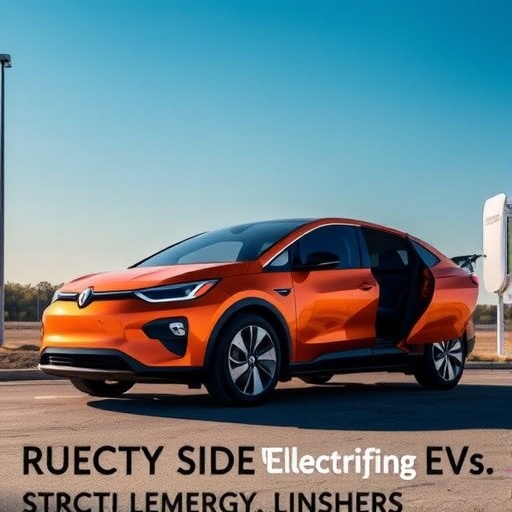The shift from gasoline-powered vehicles to electric vehicles (EVs) has emerged as a cornerstone in the fight against climate change. However, an insightful study from Northwestern University underscores a critical issue that could thwart this transition: the inadequacies of the current U.S. transmission grid. The research presents a glaring warning: even a full conversion to EVs won’t yield the expected environmental benefits unless the grid is systematically upgraded to meet new demands. This revelation introduces a complex interplay between renewable energy availability and transmission capacity, prompting necessary discussions on the infrastructure needed to sustain this bold electric future.
Despite technological advancements in renewable energy, the researchers highlight that simply replacing gas-powered cars with electric counterparts may not significantly impact carbon emissions. The core problem lies in the inability of existing transmission systems to efficiently channel clean electricity to urban charging stations. This phenomenon, termed “grid congestion,” compels the grid to revert to nearby fossil fuel power plants when demand peaks, effectively undermining the climate benefits that EV adoption is meant to deliver.
In their comprehensive analysis, the researchers delved deeper into the operational framework of the power grid, resembling an intricate highway system where electricity travels vast distances. The study employed intricate computer simulations to assess electricity flow considering various levels of EV adoption and renewable energy generation. Alarmingly, they identified grid congestion as a recurrent issue across all scenarios with significant EV uptake—underscoring its pivotal role in potential emissions reductions.
.adsslot_9ya5bnWwUT{width:728px !important;height:90px !important;}
@media(max-width:1199px){ .adsslot_9ya5bnWwUT{width:468px !important;height:60px !important;}
}
@media(max-width:767px){ .adsslot_9ya5bnWwUT{width:320px !important;height:50px !important;}
}
ADVERTISEMENT
As electric vehicle adoption accelerates, particularly in densely populated urban centers, the demand for electricity surges. The stark contrast between the locations of renewable energy infrastructure—often situated in remote areas—and the urban centers where this energy is most needed emerges as a substantial barrier. Consequently, when clean energy generation is stifled by transmission limitations, the grid resorts to drawing power from less sustainable sources, ultimately elongating the path toward reduced emissions.
A particularly illuminating simulation was conducted in which the entire fleet of vehicles in the United States was transitioned to electric power. Under optimal grid conditions with sufficient transmission capacity, the study estimated that nearly all CO2 emissions from vehicular sources could be eliminated once renewable energy production outpaced that of fossil fuels. However, existing constraints within the grid infrastructure indicated that approximately one-third of the emissions savings anticipated would, unfortunately, be forfeited due to congestion.
To illuminate potential solutions, the study proposed a series of targeted upgrades to the existing transmission network, finding that a relatively modest increase in capacity—between 3% and 13%—could drastically diminish instances of congestion. This could mean constructing new high-voltage transmission lines or expanding current infrastructure, thereby facilitating the transition of renewable energy generated in distant locations (such as wind farms and solar arrays) to urban areas with high electricity consumption, particularly where EV charging stations are concentrated.
Motter emphasized the necessity for a strategic approach that doesn’t necessitate an entire overhaul of the grid. Instead, targeted upgrades in high-demand regions can significantly counter congestion issues. The ensemble of U.S. power grids operates as three largely independent segments—Eastern, Western, and Texas—each with limited power sharing capabilities between them. Strengthening these interconnections would allow cleaner energy to reach urban areas effectively.
Moreover, the study also highlights how the logistical management of EV charging schedules can be synchronized with renewable energy availability. While advanced smart charging solutions can optimize this interaction, the fundamental element remains the availability of adequate transmission capacity to deliver energy to charging stations when and where it is required.
The findings of this study prompt essential conversations regarding energy policy and infrastructure investments as the U.S. aims to mitigate climate change through electrification. If these infrastructure limitations are not addressed, the stakes remain high and the environmental benefits of transitioning to electric transportation will be significantly diminished.
Research in this domain is critical as the global community gears toward transition strategies for cleaner energy and transportation solutions. The recommendations provided by this significant study may pave the way for successful adaptation of our energy systems to meet future demands while maintaining sustainability goals. As electric vehicles continue to gain popularity, the need for foresight in infrastructure planning becomes all the more paramount.
Subject of Research: The impact of transmission grid constraints on electric vehicle emissions benefits
Article Title: Grid congestion stymies climate benefit from U.S. vehicle electrification
News Publication Date: 6-Aug-2025
Web References: https://www.nature.com/articles/s41467-025-61976-8
References: Not provided
Image Credits: Credit: Camila Felix/Northwestern University
Keywords
Energy infrastructure, Renewable energy, Energy resources, Fossil fuels, Electric vehicles, Transportation infrastructure, Electrical power generation, Power distribution, Power plants.
Tags: clean energy transitionClimate change and transportationelectric vehicle infrastructure challengeselectrification of vehiclesenvironmental impact of EVsfossil fuel dependency in power gridsgrid congestion and EV adoptionNorthwestern University study on EVsrenewable energy transmission capacitysustainable energy solutionsU.S. power grid inadequaciesupgrading transmission systems






